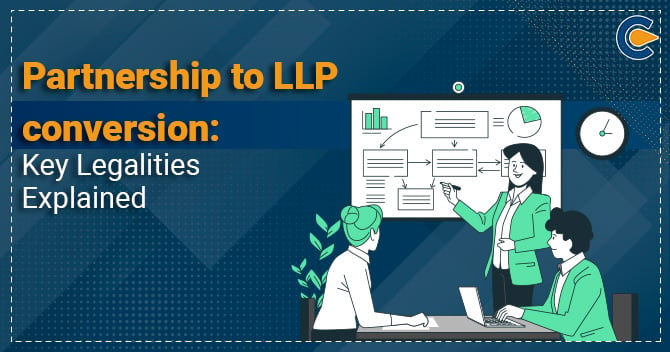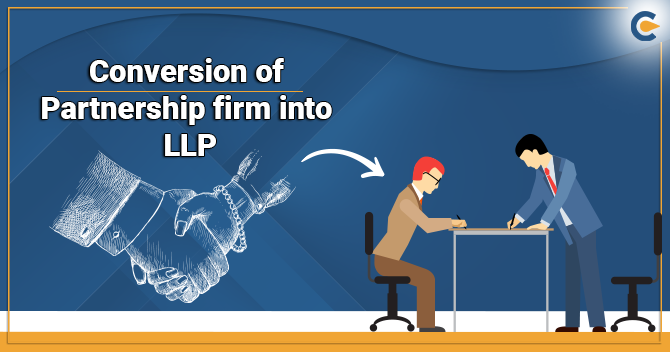The shift from conventional partnership firms to LLP has increased lately. This surge is credited to the flexible constitutional framework of LLP.
Unlike partnership firms, LLP involves minimal compliance requirements and has perpetual existence. Also, the threshold of liabilities for the LLP’s partners is limited to their contribution.
Generally, LLP is perceived as a hybrid of both a private limited company and a partnership firm. This form of business structure is ideal for small and medium-sized businesses. A partnership firm, on the contrary, is difficult to manage when it comes to stability. Also, the maximum number of partners in a Partnership Firm is 100, as compared to an LLP, which can hold unlimited number of partners. This blog will explore the legalities of the Partnership to LLP conversion in detail.
Partnership firm Vs. LLP
- LLP has leverage to operate as an independent legal entity, unlike partnership firm.
- Contrary to LLP, the personal assets of the members in a partnership firm are always at risk due to unlimited liability.
- The prevailing legislation mandates LLPs to maintain a book of an account which otherwise is not compulsory for the partnership firm.
- A DSC is not required in case of a Partnership Firm, unlike an LLP.
- DSC (Digital Signature Certificate) is mandatory for LLP Registration under the LLP Act, 2008.
- There is a limit under the Partnership Act 1932 on how many members can be a part of a partnership firm. On the other hand, LLP does not face such kind of legal constraint.
Advantages of switching to the LLP business structure
Following are the common advantages of Partnership to LLP conversion:
Flexibility and Ease of Management
The LLP business structure offers increased flexibility to the serving partners when it comes to addressing daily operations. Such business structures fall under the Limited Liability Partnership Act, 2008, promoting flexible governance and ease of management.
Perpetual Succession
Unlike a conventional partnership, LLP remains unaffected by events like apartner’s demise. LLP can withstand adverse scenarios more effectively than partnership firms.
Investment opportunities
The robust corporate structure of LLP attracts ample investment opportunities as opposed to traditional partnerships.
Conditions for Partnership to LLP conversion
- The norms around the Partnership to LLP conversion are cited under Section 55 of the LLP Act, 2008[1], read with the Schedule II of the Act.
- Any changes in the management of the partnership firm during the application filing are unacceptable for the conversion purpose. Any alternation to the management can occur after the conversion.
- It is a mandate for all serving partners to secure Digital Signature Certificate, DPIN/DIN meet conversion legalities.
- The partnership firm must fall under the Partnership Act, 1932.
- Consent of all serving partners is also essential in this regard.
Procedure for Partnership to LLP conversion
The section below entails the procedure for Partnership to LLP conversion:
Step 1: Name Approval and Digital Signature Certificate
Name approval of the proposed business is the first step in the conversion process. For this, the applicant firm needs to file an online application with the licensing authority. For additional registration formalities, the Designated Partners must hold Digital Signature Certificates. DSCs are required to validate e-forms and various other documents electronically.
Step 2 –Form filing with the RoC
File Form 17 (application pertaining to the Partnership to LLP conversion) with RoC. It must enclose the following details;
- Service Request Number generated against the RUN – LLP form.
- Proposed LLP’s name
- Name, address, and registration particulars of the firm
- Particulars such as no. of partners and capital contribution
- Creditors details
The said form must be attached with the following attachments;
- Statement of partners reflecting their confirmation for Partnership to LLP conversion
- Firm’s financial information validated by the Chartered Accountant
- Copy of the latest IT return receipt
- List of all the secured creditors and their permission
- Any other required dossiers
Step 3: File incorporation form FiLLiP
The application form must accompany the following;
- Details of the RUN – LLP (it will be auto-populated)
- Address of registered office and email contact of the LLP
- Registrar’s office
- Nature of business undertakings
- Details pertaining to partners, designated partners, their DPINs, DINs, and PANs
- Sum of partners’ contribution to the firm
- The duly filled FiLLiP form must carry the following attachments:
- Address proof relating to the LLP’s registered office
- Subscriber’s consent
- NOC issued by the premises’ owner along with a copy of utility bills which should be the latest ones
- Consent of any licensing authority
- Details of any company where partner(s) concerned are serving the designation of director/partner.
- Proof relating to the address and identity of the applicant
- Where the name of the LLP is similar to any prevailing LLP/firm, a NOC from the latter or a copy of the board resolution is mandatory.
The said forms must enclose the signature of the proposed designated partners and be validated by a CS, CA, or a Chartered Accountant. The fee for such registration differs in accordance with the amount of capital contribution.
Step 4– Issuance of Certificate of Registration
The RoCissues the registration certificate of the LLP after successful document vetting.
Step 5 – Furnish LLP Agreement
The LLP Agreement must be furnished in Form LLP-3 within thirty days from the date of incorporation. It mustenclose the following details.
- LLP’s name
- Designated partners’ name
- Form of capital contribution as well as the profit-sharing ratios
- Provisions that regulate the LLP
- Rights and obligations of the designated partners
Step 5 – Intimation to the Registrar
The Registrar of Firms must be notified about the Partnership to LLP conversion and other details within fifteen days from the incorporation date via form-14. The application form must carry;
- Copy of certificate of incorporation
- a copy of the documents attached with the Form FiLLiP.
This brings to an end the procedure relating to the Partnership to LLP conversion. It is worth noting that old permits and licenses issued to the partnership firm would not remain effective post successful conversion.
Effect of Partnership to LLP conversion
- An LLP cannot use a name other than listed in the registration certificate.
- All the finances, privileges, and rights vested in the firm must be transferred to the LLP.
- The firm shall not remain operational under the Indian Partnership Act 1932. Its credentials shall be discarded from the records in place.
- The pending cases would be shifted to LLP after completing the procedure of Partnership to LLP conversion. The same is true for previous judgement or orders either in favour or against the firm.
- All prevailing agreements and contracts shall continue to remain in effect with the LLP as the party.
Liabilities of partners before conversion
Every partner will be collectively accountable for all the firm’s obligations, be it related to finances or other subject matters. If any partner discharges the obligation, then he/she shall be compensated by the LLP.
Conversion Notice
Post conversion every LLP is mandated to draft a notice relating to the conversion. The said notice should enclose key details including;
- Date of conversion
- Incorporation number of the firm
This notice shall help LLP to address event-based compliances in future. According to the LLP Act, 2008, the said requirement should be met within 12 months period. This timeline would come to effect post 14 days from the incorporation date.
Failure to meet this condition shall attract the penalty ranging from Rs 10000-Rs 100000 for the defaulting company. In the event of a continuing violation, the minimum penalty of Rs 50/day, and maximum of Rs 500/day shall be imposed.
Conclusion
Partnership to LLP conversion is a tedious and complicated procedure that involves a lot of paperwork. In case you are not comfortable with meeting the above conversion requisites, then hire a professional for such a purpose. At Corpbiz, our professionals can handle the legalities on your behalf and achieve the desired conversion in a hassle-free manner.











